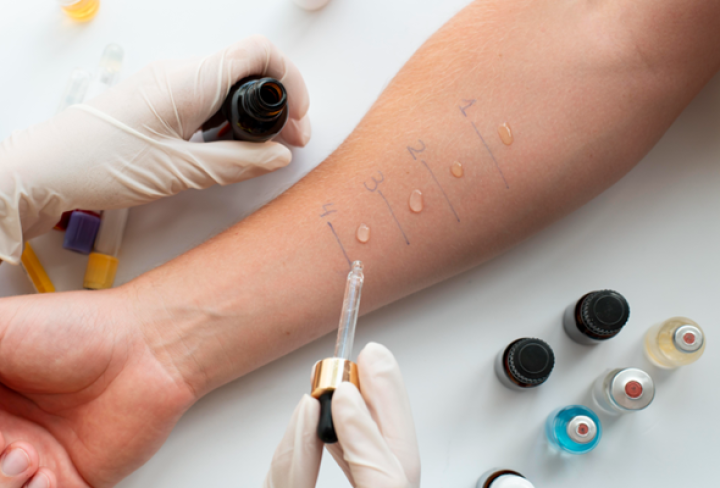Do you often struggle with sneezing, itching, or hives but can’t pinpoint the cause? Allergies are a common issue that affects millions worldwide, but the good news is that they’re manageable once the triggers are identified. One of the most reliable and widely used methods for allergy diagnosis is the skin prick test. It’s a quick, safe, and effective way to identify allergens and start your journey toward better health. In this guide, we’ll break down everything you need to know about skin prick testing.
What Is a Skin Prick Test?
A skin prick test is a diagnostic procedure that helps identify substances (allergens) that may be causing allergic reactions. By introducing small amounts of potential allergens to your skin, the test measures your body’s response to these triggers. It’s commonly used for conditions like:
- Seasonal allergies (hay fever)
- Food allergies
- Allergic asthma
- Eczema (atopic dermatitis)
- Drug allergies
The test is minimally invasive and usually provides results within 15-30 minutes.
How Does the Skin Prick Test Work?
The process is straightforward and involves several steps:
- Preparation: The healthcare provider cleans a small area of your skin, typically on your forearm or back.
- Allergen Application: Small drops of allergen extracts are placed on the skin.
- Pricking the Skin: A tiny, sterile needle gently pricks the skin through each drop to allow the allergen to enter the surface layer.
- Observation: After about 15 minutes, the provider checks for reactions like redness, swelling, or itching.
- Recording Results: A positive reaction indicates sensitivity to a particular allergen.
The size of the reaction helps determine the severity of your allergy.
Who Should Consider a Skin Prick Test?
If you’re experiencing symptoms like sneezing, runny nose, skin rashes, or difficulty breathing and suspect an allergy, a skin prick test could provide the answers you need. This test is particularly helpful for:
- Children: It’s safe and effective for diagnosing allergies in kids.
- Adults: Especially those with persistent or unexplained allergic reactions.
- Individuals with family histories of allergies: Understanding your triggers early can help you manage them better.
What Can a Skin Prick Test Detect?
The test covers a wide range of allergens, including:
- Environmental Allergens: Pollen, dust mites, mold, and pet dander.
- Food Allergens: Milk, eggs, peanuts, shellfish, and wheat.
- Insect Allergens: Bee venom and other stinging insects.
- Drug Allergens: Penicillin or other medications.
Your healthcare provider will tailor the test to your specific symptoms and concerns.
Preparation: What to Do Before the Test
To ensure accurate results, you’ll need to follow a few preparation guidelines:
- Avoid Antihistamines: Stop taking antihistamines at least 3-7 days before the test, as they can interfere with results.
- Inform Your Doctor About Medications: Certain medications, like antidepressants or steroids, may need to be paused temporarily.
- Wear Comfortable Clothing: Ensure easy access to your forearms or back.
- Communicate Your Symptoms: Share your medical history and allergy concerns with your doctor.
Benefits of Skin Prick Testing
Why is skin prick testing the gold standard for allergy diagnosis? Here are the key benefits:
- Quick Results: Know your triggers within 15-30 minutes.
- Non-Invasive: No blood draws or complex procedures required.
- Cost-Effective: A simple and affordable diagnostic tool.
- Accurate Diagnosis: Helps identify both mild and severe allergens.
What Happens After the Test?
Once your results are in, your doctor will discuss them with you. If a positive reaction is observed, the next steps may include:
- Allergy Avoidance: Tips for avoiding specific allergens.
- Medications: Antihistamines, nasal sprays, or eye drops to manage symptoms.
- Immunotherapy: Allergy shots or oral tablets to desensitize your body to allergens over time.
- Lifestyle Adjustments: Dietary changes for food allergies or home modifications for environmental allergens.
Is the Test Safe?
The skin prick test is generally safe for most people. Side effects, if any, are mild and include temporary redness or itching at the test site. Severe reactions are rare but can occur in individuals with highly sensitive allergies. To ensure your safety, the test is always conducted under medical supervision.
Common Myths About Skin Prick Testing
Let’s bust some myths about allergy testing:
- Myth: The test is painful.
- Fact: The pricks are very gentle and feel like tiny pinches.
- Myth: It’s only for severe allergies.
- Fact: The test can detect both mild and severe allergies.
- Myth: I can self-diagnose using online tests.
- Fact: Only a professional test can provide accurate and reliable results.
Managing Your Allergies Post-Test
Getting diagnosed is just the beginning. Managing allergies effectively involves a comprehensive care plan:
- Medication: Follow your doctor’s advice for antihistamines, decongestants, or corticosteroids.
- Immunotherapy: Long-term solutions for severe allergies.
- Environmental Control: Use air purifiers, dust-proof covers, and keep pets out of certain areas in your home.
- Dietary Adjustments: Avoid foods you’re allergic to by reading labels carefully.
When to Repeat the Test
Allergies can change over time. It’s a good idea to retake the test every few years or if your symptoms worsen or evolve.
Are allergies holding you back? Get clarity with a skin prick test today. Our experienced healthcare team is here to help you identify and manage your triggers effectively. Don’t let allergies control your life—schedule your test now and breathe easier!



